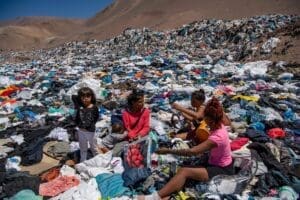Mountains of discarded clothes, new clothes that have not sold, in the Chilean Desert
There is an inherent conflict between capitalism and the circular economy. This is made most glaringly apparent in the fast fashion industry.
The circular economy is a model that involves sharing, leasing, reusing, repairing, refurbishing, and recycling existing materials and products as long as possible. In this way, the life cycle of products is extended. In practice, it implies reducing waste to a minimum. As large companies embrace environmental, social, and governance goals, they also need to revamp their reverse supply chains to disassemble returned goods apart, save valuable materials, and reuse them. Or, to refurbish and resell goods that are repairable.
In some industries, like electronics, legislation is requiring that electronic waste be reduced. Despite legislation, in 2022, the world generated 62 million metric tons of e-waste, according to the United Nations Global E-waste Monitor. This waste could fill more than 1.5 million 40-metric-ton trucks which, if placed bumper-to-bumper, would form a line long enough to wrap around the equator.
But other industries’ performance is far worse. The apparel industry is a prime example. The Environmental Protection Agency estimates that 11.3 million tons of textile waste ended up in US landfills in 2018.
Within the apparel industry, the waste generated by the fast fashion segment is particularly insidious. Landfills in wealthy nations are not the issue. Fast fashion refuse is exported to the third world. A mountain of unsold fast fashion clothing items in the Atacama Desert in Chile has grown so large that satellites have captured clear images of it.
Businesses, of course, seek to maximize profits. That is the heart of capitalism. Advertising is at the heart of getting consumers to buy. Whether consumers really need the goods or not is another issue. This is not a new idea. In 1899, the sociologist Thorstein Veblen coined the term “conspicuous consumption” to explain the spending of money to acquire luxury commodities specifically as a public display of wealth. The public display of discretionary income signals high social status and can make the person displaying that wealth seem more desirable.
For years, The Hidden Persuaders was required reading in college sociology classes. In this book, first published in 1957, the author—Vance Packard—explored advertisers’ use of psychological techniques to induce desire for products. He identified eight “compelling needs” that advertisers promise products will fulfill – a sense of power, emotional security, reassurance of worth, ego gratification, creative outlets, love objects, roots, and immortality.
There are purveyors of recycled and refurbished clothes. Stuart Trevor, an industry veteran, has created a company called “Cats Who Care.” The company takes back used garments, refurbishes them, and adds clever artwork to the garment. Mr. Trevor pulls no punches when he talks about fast fashion. At Infor Nexus’s European Advisory Customer Council meeting in Chamonix, France, Mr. Trevor told the audience, “Fast fashion is crap…” Customers should buy clothes that are “well made and have longevity.”
A prime example of a fast fashion brand is Zara. In the early 2000s, the Spanish retailer Zara developed a business model built on agile and responsive supply chain capabilities that created the fast fashion industry. Defying conventional wisdom, Zara designed and distributed garments to market in just fifteen days. In contrast to the traditional apparel supply chain that took months to bring garments made in Asia to market. They were lauded for their supply chain acumen.
But other brands and retailers believe in well-made, long-lasting, repairable goods. The retailer DECATHLON allows customers who have bought their tents to send them back through their reverse supply chain to be repaired and cleaned. The cost of these tents, according to Mr. Trevor, is half of the cost of a new tent. DECATHLON has been working for several years on the design of its products to extend their lifespan. They seek to design goods that offer not just high performance and reliability but are also durable. In the design phase, their goal is also to build goods that are easier to repair.
Patagonia offers an ironclad guarantee: “We guarantee everything we make. If you are not satisfied with one of our products at the time you receive it, or if one of our products does not perform to your satisfaction, return it to the store you bought it from or to Patagonia for a repair, replacement or refund. Damage due to wear and tear will be repaired at a reasonable charge.”
However, the market for refurbished clothes, or sturdy clothing that is repaired, is likely to remain a niche. People who buy this clothing are concerned with the environment or believe in living a simple, unpretentious life. Consumers who want to signal they are wealthy, sexy, fit, or hip are likely to always far outnumber them.
The post In Fast Fashion, the Tug of War Between the Circular Economy and Capitalism is Glaringly Apparent appeared first on Logistics Viewpoints.
